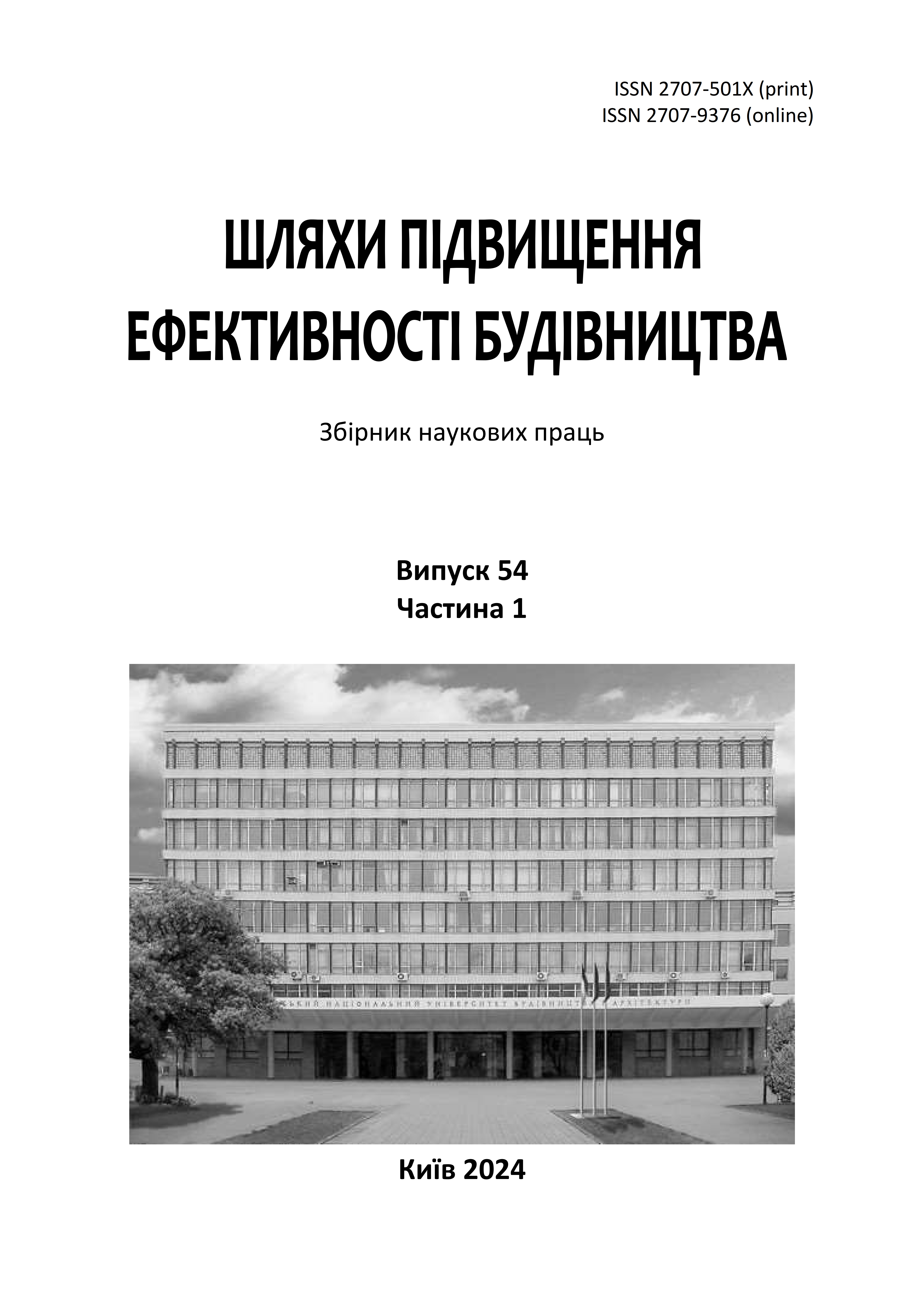Problems of choosing column foundation structures according to labor consumption and productivity of their arrangement
DOI:
https://doi.org/10.32347/2707-501x.2024.54(1).139-147Keywords:
frame buildings, columnar foundations, prefabricated-monolithic elements, construction technology, low-rise buildings, construction efficiencyAbstract
Reinforced concrete frame structures are often used in construction practice due to a successful combination of the characteristics of the cost and duration of construction work, as well as the versatility of the purpose of ready-made buildings. The construction industry strives to combine such areas of development as speeding up building construction, reducing labor-intensive processes and lowering the cost of work and materials - without losing the quality characteristics of the finished building. In order to achieve the listed properties, the development and invention of new equipment, materials and structural and technological solutions is taking place. The construction of columnar foundations takes about 15-20% of the time resource, so there is a need to find solutions that can speed up the processes and make them cheaper.
The modern level of development of the construction industry allows the use of various structures and equipment, as well as combining technological solutions for the arrangement of structures and individual elements, in particular columnar foundations. A popular solution is the installation of prefabricated monolithic foundations, which, in its finished form, should combine the advantages of prefabricated and monolithic technologies. The possibility of combining modern solutions and technologies requires research to determine the expediency and effectiveness of constructive solutions, as well as to determine the algorithm of actions. The question arises about the prospects of modern methods. This article provides an overview of the existing solutions that can be used for the installation of prefabricated monolithic foundations, taking into account the structural requirements in accordance with current regulations. The main advantages and disadvantages of each of the solutions, as well as the conditions of application, are determined. Methods of using modern prefabricated structures, equipment, as well as the combination of technology of prefabricated monolithic foundations are considered in order to find options that meet the needs. It was determined that there is not enough analytical and empirical data regarding the effectiveness of the adopted decisions in interaction with the rest of the factors, such as structural and technological solutions of the remaining elements of the building, volume-planning solutions, conditions of the construction site, environmental conditions.
References
Тонкачеєв Г.М. Перспективи та ефективність зведення будівель за збірно-монолітною технологією. Шляхи підвищення ефективності будівництва в умовах формування ринкових відносин. 2013. № 30. С. 226-233.
Черненко В.К., Ярмоленко М.Г., Батура Г.М. та ін. Технологія будівельного виробництва: підручник. За ред. В. К. Черненка, М.Г. Ярмоленка. К.: Вищ. шк., 2002. 430 с.
Тонкачеєв Г.М., Лепська Л.А., Шандра О.Г. Проектування технології улаштування фундаментів каркасних будинків: методичні вказівки до проведення практичних занять та виконання курсового проєкта (роботи) освітньої компоненти «Технологія будівельного виробництва». Київ: Видавництво Ліра-К, 2023. 62 с.
З’єднання колон з фундаментом. URL: https://oberbeton.ua/uk/колони
Foundations & Footings. Sabri Farah International. Precast concrete producer. URL: https://sfi-precast.com/products/foundations/
Golewski Gr.L. The Specificity of Shaping and Execution of Monolithic Pocket Foundations (PF) in Hall Buildings. Buildings. 2022, 12(2), 192.
Тонкачеев Г.Н, Тихомиров Е.В., Колесниченко В.Г., Самойлович В.В. Способ монтажа колон: пат. №969865 СССР, Е 04 G 21/26; №3008838/29–33; заявл. 26.11.80; опубл. 30.10.82, Бюл. № 40. 3 с. https://patents.su/?search=%E2%84%96969865+&type=number
ДСТУ-Н Б В.1.1-27:2010. Будівельна кліматологія. [Чинний від 2010-12-16]. Київ: ДП «НДІБК», 2010. 123 с. (Інформація та документація).
ДБН В.2.1-10:2018. Основи і фундаменти будівель та споруд. Основні положення. [Чинний від 2019-01-01]. Київ: Мінрегіон України, 2018. 36 с. (Інформація та документація).
Тонкачеєв Г.М., Черненко К.В., Лепська Л.А., Шандра О.Г. Варіантне проєктування інноваційних технологій каркасного будівництва: методичні вказівки до виконання практичних занять та розробки курсової роботи з освітньої компоненти «Дисципліни спеціальної підготовки». Київ: КНУБА, 2023. 78 с.
Тонкачеєв Г.М., Молодід О.С., Тонкачеєв В.Г., Шандра О.Г. Інноваційні технології каркасного будівництва: навч. посіб. Київ: Ліра-К, 2024. 316 с.
Downloads
Published
How to Cite
Issue
Section
License

This work is licensed under a Creative Commons Attribution 4.0 International License.
Authors who publish with this journal agree to the following terms:
- Authors retain copyright and grant the journal right of first publication with the work simultaneously licensed under a Creative Commons Attribution License that allows others to share the work with an acknowledgement of the work's authorship and initial publication in this journal.
- Authors are able to enter into separate, additional contractual arrangements for the non-exclusive distribution of the journal's published version of the work (e.g., post it to an institutional repository or publish it in a book), with an acknowledgement of its initial publication in this journal.
- Authors are permitted and encouraged to post their work online (e.g., in institutional repositories or on their website) prior to and during the submission process, as it can lead to productive exchanges, as well as earlier and greater citation of published work (See The Effect of Open Access).

